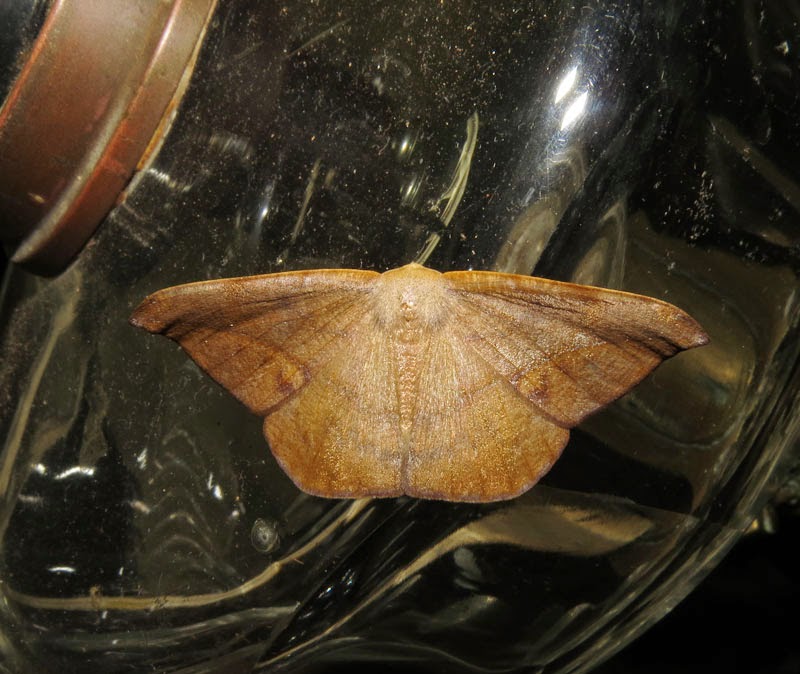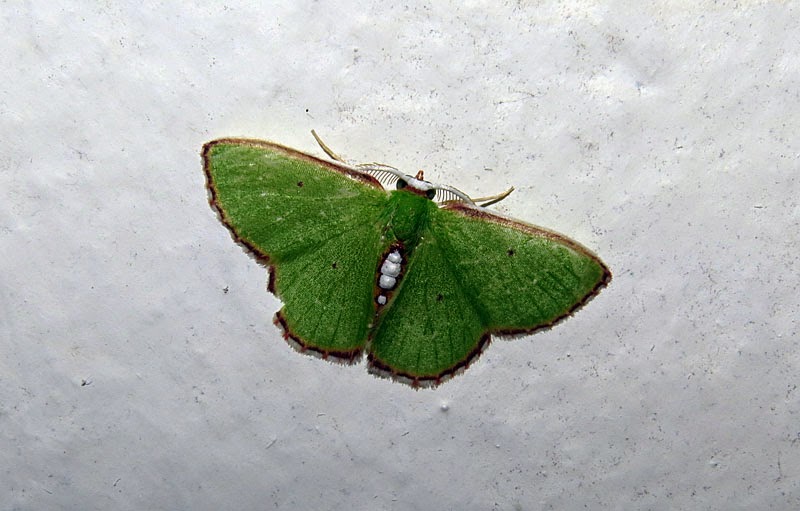This year
was my 16th WINGS tour to Jamaica, but only in recent years have I
been avidly photographing and trying to identify the moths. It doesn’t cut into
the birding, as they are either around lights at night or are sleeping of the
walls of our hotels, when I can photograph them during our down time.
How does one
go about identifying moths? There are no books for Jamaica that I know of
(though I’d love to have the one from Cuba), but there are some good websites.
I usually first start with Matthew
Barnes’ site, which has at least a complete list of known species from the
island as well as specimen photos of many of them.
Then there’s
the fabulous Moth
Photographers Group, which has a full checklist for the Antilles, as well
as some very good photos of live insects and specimens.
Sometimes
there are widespread species with a better series of photographs available on
the well-known Bugguide.
Finally
there is amazing Bold Systems website
which has some specimen photos not found anywhere else.
The most
exciting moth this time, partly for its beauty was the Jamaican Phrygionis, Phrygionis sumptuosaria, pictured at the top. But it was the way I
identified it and the fact that it’s endemic that made it so special. It only
took a little bit of searching to recognize the genus – I’d seen a couple in
Central and South America before. Then I went to Matthew’s site where he lists
four species but has photos for only one – and it wasn’t that one. Searching
elsewhere showed that one of the four in his list is an invalid synonym of one
of the other two, and I found photos of that one on Bugguide and Moth
Photographers Group – not it either. That left the final one, which Matthew
lists as an endemic, and other websites and googling turned up nothing on it at
all. Matthew is great at including references, and he mentions a “Scoble
(1994)” and googling that along with Phrygionis turned up the full citation, a
paper in the Zoological Journal of the Linnean Society, but available online at
Wiley Online Library for subscribers or some huge one-time fee. But I have
friends at universities that do have such a subscription, and within a few
hours I had the pdf in my email box which showed without a doubt this was the
endemic species.
To continue
just with the photos, nothing all that exciting, but some pretty ones.
I don’t have
a common name for this tiny geometer (inchworm), Lobocleta tenellata, at Marshall’s Pen.
This one was
pretty much identified by process
of elimination – the endemic Jamaican Spanworm Moth, Oxydia olivacea at Marshall’s Pen.
This
geometer is the very widespread Herbaria Emerald, Synchlora herbaria.
Another
lovely green geometer, this is possibly the endemic Kingston Emerald, Phrudocentra kinstonensis, pretty much
identified by process of elimination; it’s very similar to others in this
genus, but I could find nothing that looks exactly like this, and this is the
one species for which no photos are available. There’s an illustration on
Matthew’s site from a 1925 publication, but it does not show the dark spots on
the body.
Yet another
geometer, this one was easy – Common Angle Moth, Macaria aemulataria.
The Satellite
Sphinx, Eumorpha satellitia is a
widespread insect. It was in my room at Goblin Hill. To get photos like this,
you really have to manhandle these strong sphingids and not be startled by the
sharp spines on the legs (they prick a bit but are not as sharp as they seem at
first).
This is what
I’m calling Common Mocis, Mocis diffluens;
it’s very widespread in the American tropics, but I needed a combination of
sites to figure it out. This was in the Cockpit Country
This noctuid
is the Famelica Melipotis, Melipotis
famelica. Melipotis a rather large genus, and it always helps to have the
pattern of the hind wing.
This little
pyralid moth is the Recurved Salobrena, Salobrena
recurvata, apparently known as a stray to Florida, with two Bugguide photos
from there.
This crambid
is the Pickleworm Moth, Diaphania
nitidalis. Its caterpillars feed on (and destroy) the flowers of squash and
many other members of the cucumber family. It’s a tropical species that can
survive some winters in Florida but after one or two broods can disperse way to
the north.
It’s not
always possible to identify moths with just photos. This is probably Atomosa
Tussock Moth, Lophocampa atomosa, a
notoriously variable species, though none of the photos I found look exactly
like mine.
And this is probably
Steely Tiger Moth, Uranophora (or Napata) chalybea, the 1925 drawing on Matthew Barnes’ website not being a
perfect match, but there aren’t a lot of options for showy ctenuchine moths.
Finally,
here’s one I managed to get to genus only: Hypena
sp. There are nine species in Jamaica, and the five that have photos online
do not match well. Two of the remaining four are endemic. This was high in the
Blue Mountains at Starlight Chalet, and I photographed this species here a
couple years ago. I suspect it’s one of the endemics (H. leniusculalis or H.
lunifera), as many of the high elevation species of birds and plants are
endemic here. More widespread tropical things tend be found in the lowlands.
Finally,
some are just too puzzling, and I don’t even know which family this one is in.
Maybe I’ll stumble into it some day, but for now it’s just “moth species.”
Next blog
will be about other critters we had on the tour.




















I like your photos!
ReplyDelete-A. Cunningham, insect identifier
Your photograph tentatively identified as Uranophora chalybea is not a correct ID. Would love to know the location and date of this photo.Thanks,
ReplyDeleteTom Turner
Hi Tom, thanks for your comment. This was at Marshall's Pen at about 10:00 in the morning. What do you think it is?
DeleteYou could try Phidotricha erigens (Pyralidae) for your last image above... loved the way that you co-ordinated my old site and others to get identifications! Best Wishes, Matthew Barnes
ReplyDeleteThank you so much for the comment Matthew. And thank you for all your work to create the moth site.
Delete